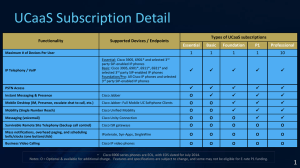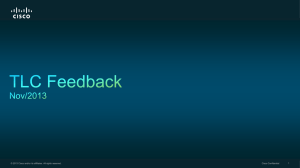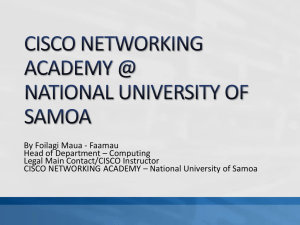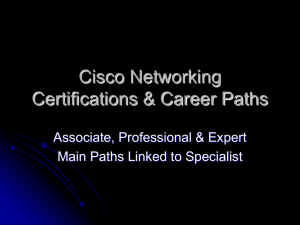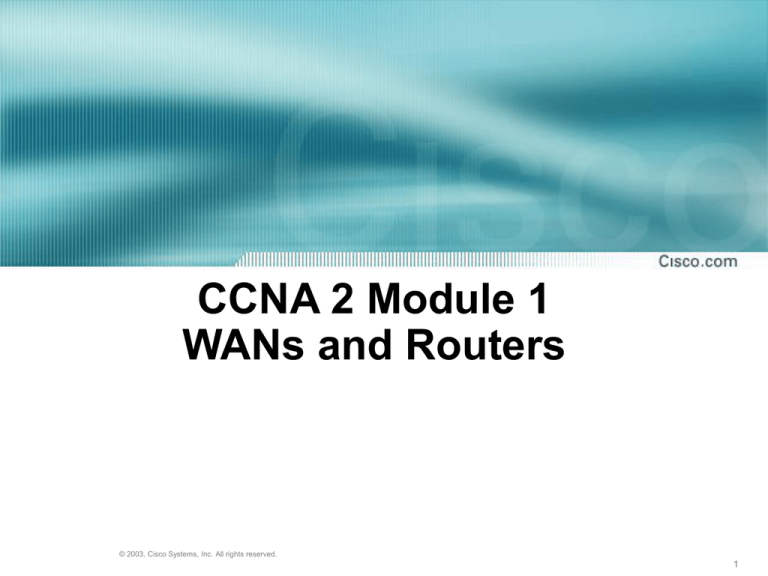
CCNA 2 Module 1
WANs and Routers
© 2003, Cisco Systems, Inc. All rights reserved.
1
Objectives
• Upon completion of this module, the
student will be able to perform tasks
related to the following:
• WANs
• Routers
© 2003, Cisco Systems, Inc. All rights reserved.
2
Introduction to WANs
• A wide-area network (WAN) is a data
communications network spanning a large
geographic area such as a state, province, or
country.
• They use the services of carriers.
• A WAN operates at the physical layer and the
data link layer of the OSI reference model.
• It interconnects LANs that are usually
separated by large geographic areas.
© 2003, Cisco Systems, Inc. All rights reserved.
3
Introduction to WANs
• WAN data link protocols describe how frames
are carried between systems on a single data
link.
• They include protocols designed to operate
over dedicated point-to-point, multipoint, and
multi-access switched services such as
Frame Relay.
© 2003, Cisco Systems, Inc. All rights reserved.
4
WAN Devices
© 2003, Cisco Systems, Inc. All rights reserved.
5
WAN Services
© 2003, Cisco Systems, Inc. All rights reserved.
6
Data Link Encapsulations
© 2003, Cisco Systems, Inc. All rights reserved.
7
Introduction to Routers in a WAN
• Routers connect and allow
communication between two
networks and determine the
best path for data to travel
through the connected
networks.
• Routers need the
Internetwork Operating
System software (IOS) to run
configuration files.
• The main internal components of the router are random access
memory (RAM), nonvolatile random-access memory (NVRAM),
flash memory, read-only memory (ROM), and interfaces.
© 2003, Cisco Systems, Inc. All rights reserved.
8
RAM
• Stores routing tables
• Holds ARP cache and fast-switching cache
• Performs packet buffering (shared RAM)
• Maintains packet-hold queues
• Provides temporary memory for the configuration file of
the router while the router is powered on
• Loses content when router is powered down or restarted
© 2003, Cisco Systems, Inc. All rights reserved.
9
NVRAM
• Provides storage for the startup configuration file
• Retains content when router is powered down or
restarted
© 2003, Cisco Systems, Inc. All rights reserved.
10
Flash Memory
•Holds the operating system image (IOS)
•Allows software to be updated without removing and
replacing chips on the processor
•Retains content when router is powered down or
restarted
•Can store multiple versions of IOS software
•Is a type of electronically erasable, programmable ROM
(EEPROM)
© 2003, Cisco Systems, Inc. All rights reserved.
11
ROM
• Maintains instruction for power-on self test (POST)
diagnostics
• Stores bootstrap program and basic operating system
software
• Requires replacing pluggable chips on the motherboard
for software upgrades
© 2003, Cisco Systems, Inc. All rights reserved.
12
Interfaces
• Connect router to network for frame entry and exit
• Can be on the motherboard or on a separate module
© 2003, Cisco Systems, Inc. All rights reserved.
13
Router LANs and WANs
• While a router can be used to segment LANs, its major use is
as a WAN device.
• Routers have both LAN and WAN interfaces
• WAN technologies are frequently used to connect routers and
these routers communicate with each other by WAN
connections.
© 2003, Cisco Systems, Inc. All rights reserved.
14
Router LANs and WANs
© 2003, Cisco Systems, Inc. All rights reserved.
15
Router LANs and WANs
Routers are the backbone devices of large intranets and of the Internet.
© 2003, Cisco Systems, Inc. All rights reserved.
16
Router LANs and WANs
• Two main functions of a router are the selection of best path
and the switching of frames to the proper interface.
• Routers accomplish this by building routing tables and
exchanging network information with other routers.
© 2003, Cisco Systems, Inc. All rights reserved.
17
Segmentation with Routers
© 2003, Cisco Systems, Inc. All rights reserved.
18
WAN Physical Layer
© 2003, Cisco Systems, Inc. All rights reserved.
19
WAN Data Link Layer Protocols
© 2003, Cisco Systems, Inc. All rights reserved.
20
WAN Standards and Protocols
WAN physical layer standards
and protocols:
• EIA/TIA-232
• EIA/TIA-449
• V.24
• V.35
• X.21
• G.703
• EIA-530
• ISDN
• T1, T3, E1, and E3
• xDSL
• SONET
WAN data link layer standards and
protocols:
• High-level data link control (HDLC)
• Frame Relay
• Point-to-Point Protocol (PPP)
• Synchronous Data Link Control
(SDLC)
• Serial Line Internet Protocol (SLIP)
• X.25
• ATM
• LAPB
• LAPD
• LAPF
© 2003, Cisco Systems, Inc. All rights reserved.
21
Internal Components of a 2600 Router
© 2003, Cisco Systems, Inc. All rights reserved.
22
External Connections on a 2600 Router
© 2003, Cisco Systems, Inc. All rights reserved.
23
Router External Connections
© 2003, Cisco Systems, Inc. All rights reserved.
24
Computer or Terminal Console
Connection
© 2003, Cisco Systems, Inc. All rights reserved.
25
Modem Connection to Console or
Auxiliary Port
© 2003, Cisco Systems, Inc. All rights reserved.
26
Connecting Console Interfaces
1.
Configure terminal emulation software on the PC for
the following:
The appropriate com port
9600 baud
8 data bits
1 stop bit
No parity
No flow control
2.
Connect a rollover cable to the router console port
(RJ-45 connector).
3.
Connect the other end of the rollover cable to the RJ45 to DB-9 adapter
4.
Attach the female DB-9 adapter to a PC.
© 2003, Cisco Systems, Inc. All rights reserved.
27
Connecting Router LAN Interfaces
•
A router is usually connected to a
LAN through an Ethernet or Fast
Ethernet interface.
•
The router is a host that
communicates with the LAN
through a hub or a switch.
•
A straight-through cable is used to make this connection.
A 10BASE-TX or 100BASE-TX router interface requires
•
Category 5, or better, unshielded twisted-pair (UTP)
cable, regardless of the router type
© 2003, Cisco Systems, Inc. All rights reserved.
28
Connecting Router Interfaces
© 2003, Cisco Systems, Inc. All rights reserved.
29
Router Serial WAN Connectors
© 2003, Cisco Systems, Inc. All rights reserved.
30
Router Serial WAN Connectors
© 2003, Cisco Systems, Inc. All rights reserved.
31
DCE Serial Connections
© 2003, Cisco Systems, Inc. All rights reserved.
32
Summary
© 2003, Cisco Systems, Inc. All rights reserved.
33





